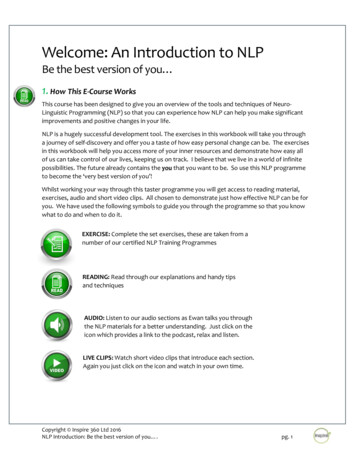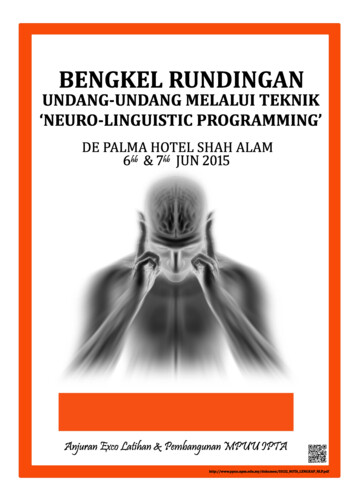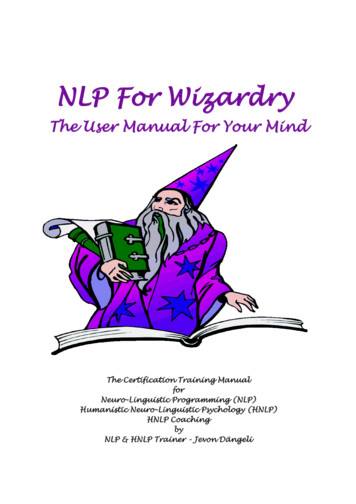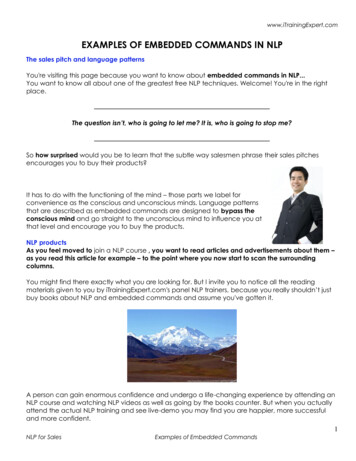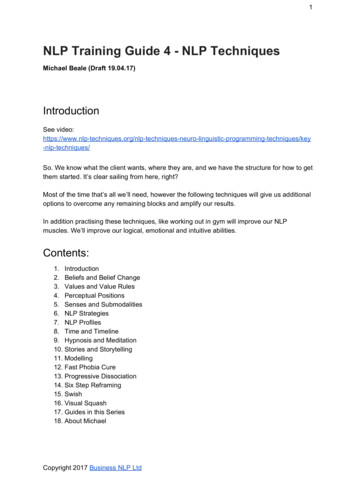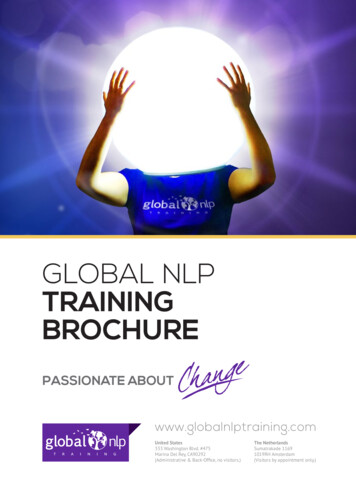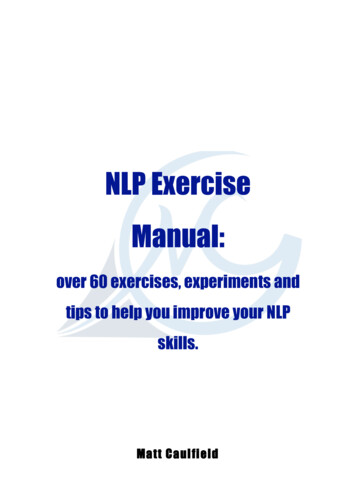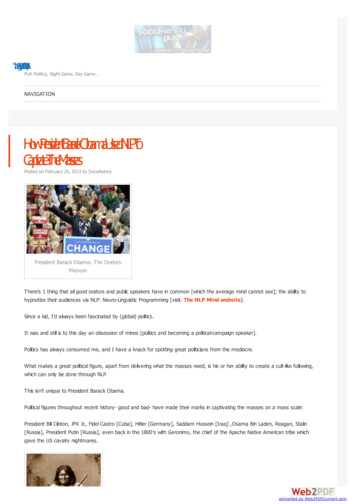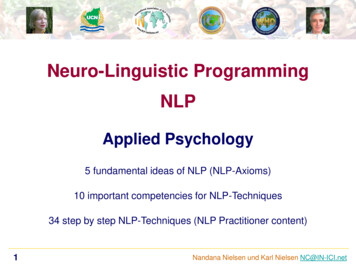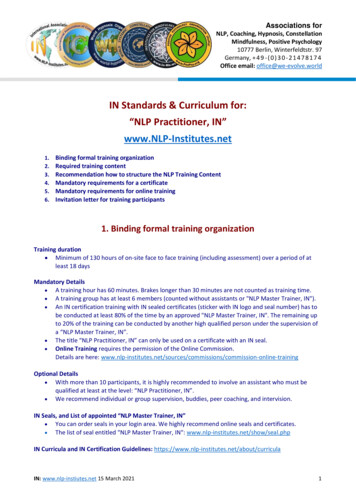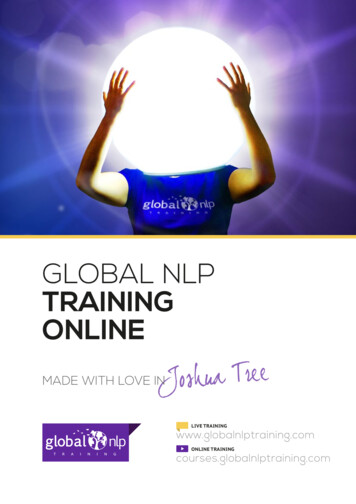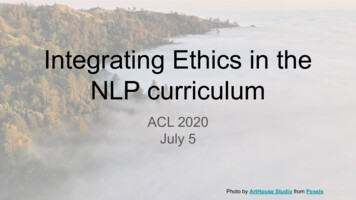
Transcription
Integrating Ethics in theNLP curriculumACL 2020July 5Photo by ArtHouse Studio from Pexels
About usEmily M. Bender: UW Linguistics, working in Ethics & NLP spacesince late 2016, starting with pulling together a class for the CLMSprogramDirk Hovy: Bocconi University, Milan, working on ethics in NLPsince 2016, interested in bias, dual use, and policy consequencesXanda Schofield: Harvey Mudd College, working on making NLPtools available to domain experts in humanities and social science,interested in privacy, undergrad education
Schedule for TodayPlenary [60min]Requests:Break [15min]1. Please stay for the wholetutorial2. Please do not logout ofZoom during the breaksBreak out sessions [30min] : ex1Plenary [30min]Break [15min]Break out sessions [30min] : ex 2Plenary [30min]
Goals for today What are some of the ethical risks of NLP technology?What are our desired outcomes from incorporating this topic into the NLPcurriculum?What are the challenges to integrating ethics into the NLP curriculum?Work through/develop sample exercises How could these be modified to fit your instructional context?Share out results of discussion to ACL community at large (via wiki)
Ground nts-courageous-conversations-and-active-learning Stay engagedExperience discomfortSpeak your truthExpect and accept non-closureMaintain confidentialityListen with the intent to learnSuspend judgment
Goals in your curriculum: Your input What is your motivation for being here?What classes are you thinking about integrating ethics into? What are theylike (grad/undergrad/other; class size; class format)?What are your goals for your students of including ethics in your NLP class?
Why is this hard? Your input What challenges do you see in getting students to engage with this material?Which learning goals are likely to be harder/easier to accomplish?
ACM Code of Ethics: https://www.acm.org/code-of-ethics Adopted by the ACL (March 2020)Key excerpt:
Section 1: Core Ethics Concepts(More reading: https://aclweb.org/aclwiki/Ethics in NLP)
BiasHas seemingly become the main topic in ethics in NLP (bias in models,embeddings, etc.).However, bias is not necessarily bad: it's a preset (or Bayesian: prior), that canhelp us make decisions absent more information.However, if this bias overwhelms the evidence, or if it influences predictivesystems, it becomes problematic.It is almost impossible to have an unbiased system.Bias can arise from data, annotations, representations, models, or researchdesign, among other things
Dual UseEvery technology has an intended use, andunintended consequences (nuclear power, knives,electricity could all be abused for things they were notoriginally designed to do).Ethicist Hans Jonas commented on the inevitability ofuse: if a technology is available, it will be used.Since we do not know how people will use it, we need tobe aware of this duality.
PrivacyPrivacy is often conflated with anonymity, but they are separate:Privacy means nobody know I am doing something, anonymity means everyoneknows what I am doing, but not that it is me.GDPR requires us to anonymize data so that people cannot be identified "withoutsignificant effort." It is unclear what that means given author attribute predictions:Given enough attributes, the set is small enough to identify people.Theoretical and differential privacy are concepts to take into account.Photo by Noelle Otto from Pexels
Normative vs. Descriptive EthicsUseful concept to distinguish moral gradation: What we want the world to be vs.what it is.A coreference system that cannot resolve female pronouns with the noun "doctor"is both normatively wrong (we want women to be doctors), and descriptively wrong(the sentence is actually referring to a female doctor).Racially or gender-biased word embeddings are normatively wrong (we do notwant the systems to proliferate stereotypes), but might be descriptively correct(they reflect how societies talk about gender and ethnicity).
Van de Poel, 2016: https://pure.tudelft.nl/portal/files/10265757/art 10.1007 s11948 015 9724 3.pdfNew Technology as a Large-Scale ExperimentNew technology like NLP can be conceived as a social experiment (Van de Poel,2016)If we assume we are all participating in a large experiment, we need to make sureit meets certain criteria of responsible experimentation: Beneficence (no harm to subjects, maximize benefits, minimize risk)Respect for subjects' autonomy (informed consent)Justice (benefits vs. harms, protection of vulnerable subjects)Photo by sl wong from Pexels
Section 2: A Few Pedagogy Concepts
Reflection Question:What goals do you have for your students inincluding ethics in your NLP teaching?Learning Outcomes: Statements of what studentswill be able to do on completion of your course,training, or program.
What are learning outcomes?Statements of what students will be able to do oncompletion of your enteredMeasurable
Bloom’s TaxonomyDescribes student activities thatcorrespond to measurable skills.Higher more complex(but not necessarily more valuable)All layers can work for differenttypes of knowledge: FactualConceptualProceduralMetacognitive
Designing assessments for learning outcomesWell-designed learning outcomes should make it easier to designmeaningful learning assessments.Example. Students should be able to.-Identify parts of speech of words in a sentenceDescribe how part of speech tags are useful in NLP tasksCompute ML parameter estimates for an HMM POS taggerImplement the Viterbi algorithmEvaluate the quality of a POS tagger
Access & universal designHow can we assume one learning strategy will workfor everyone?When possible, give multiple paths to success.
Access & universal designUniversal Design for Learning(UDL): udlguidelines.cast.orgDimensions:Why an outcome is importantWhat the material is to learnHow to practice and demonstrateknowledgeAnd how to access, build, andinternalize learning.
Nobody expects perfection.Communicating with your students can help youspend time on design where it counts.
Exercise 1: In-Class
Dual-UseLearning Outcome: Students should be able to-Recognize the dual nature of an issueAnalyze the pros and consExercise. A fellow student suggests a group project topic they want to explore:gendered language in the LGBTQ community. They are very engaged in thecommunity themselves and have access to data. Their plan is to write a textclassification tool that distinguishes LGBTQ from heterosexual language. What doyou tell the student?
Bias: Sensitivity to language variationLearning Outcome: Students should be able to-Describe the potential impact of linguistic variation on the functioning ofNLP/speech technologyReason about how differential performance for different social groups canlead to adverse impactsArticulate what kind of documentation should accompany NLP/speechtechnology to facilitate safe deployment
Bias: Sensitivity to language variation Pick an application of speech/language technology, determine what kind oftraining data is typically used for it (whose language? recordedwhen/where/how?).Next, imagine real world use cases for this technology. What speaker groupswould come in contact with the system?If their language differs substantially from the training data, what would thefailure mode of the system be and what would the real-world impacts of thatfailure be?How could systems, their training data or documentation be designed to berobust to this kind of problem?
PrivacyLearning Outcome: Students should be able to-Select possible de-anonymizing features from documentsUse statistics to argue about the effect of a document on a simple modelExercise. Consider a simple Naive Bayes classifier trained on a subset of 20Newsgroups using word frequencies as features. For five sample messages, couldyou tell whether or not they were included in the subset? How would you check?How certain could you be?
Follow-up questionsHow does this adapt to your class format and composition?What preparation would students need, and how would you provide it?How would you assess student understanding from this exercise?Get started here: https://bit.ly/teachingnlpethics
Exercise 2: Project Work
Dual-UseLearning Outcome: Students should be able to-Come up with arguments and explanations of unintended useDevice responsible ways to address dual use issuesExercise. One group develops a tool to detect personal attributes with highaccuracy. Another group tries to "break" this tool.Why, or why not, should you release it as an app?Related discussion exercise. An ACL submission claims to be able to undo ciphersused by dissenters on social media. Who benefits from this? Is it better to releaseit in a peer-reviewed venue than to not know it?
BiasLearning outcome. Students should be able to:-Measure effect of bias in word vectors on a sentiment analysis systemDiscuss implications of treating found discourse as an objectiverepresentation of the worldExercise: -racist-ai-without-really-trying/ (by Robyn Speer)Exercise: Read and discuss growing literature on debiasing embeddings. Whatwould make embeddings “safe” enough to use? How would we test that for givenapplications?
PrivacyLearning Outcome: Students should be able to-Implement an inverted index for unigram searchesUse the randomized mechanism of differential privacyExercise. Design a small search engine around an inverted index that usesrandom integer noise from a two-sided geometric distribution (Ghosh et al., 2012)to shape which queries are retrieved. Analyze how much this changes the searchresults with different noise levels. Are there systematic changes?
Follow-up questionsHow does this adapt to your class format and composition?What preparation would students need, and how would you provide it?How would you assess student understanding from this exercise?Get started here: https://bit.ly/teachingnlpethics
Wrap-up
Core ideas to walk away withTeach students to ask questions, rather than treat ethics as a checklist. Who will this impact and how?Where are possible sources of ethical problems?What do I need to learn about in order to deploy this safely?Present NLP as part of broader socio-technical systems, rather than just technicalsolutions.Our students have future roles as technologists, informed consumers, informedreaders of media reports and informed advocates for appropriate policy
How do we integrate this into a class?Courses are hard to change overnight!-Gather feedback as you test new exercises and assessmentsCenter student experience and learningPursue a goal of having ethics integrated with your class
Future directionsHow can we continue the conversation we started here?-Wiki?Website?Collection of case studies? ?“What’s learned here, leaves here. What’s shared here, stays here.”
Thanks for participating!
Emily M. Bender: UW Linguistics, working in Ethics & NLP space since late 2016, starting with pulling together a class for the CLMS program Dirk Hovy: Bocconi University, Milan, working on ethics in NLP since 2016, interested in bias, dual use, and policy consequences Xanda Schofield: Ha
